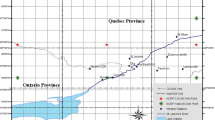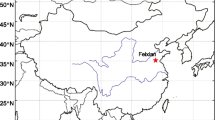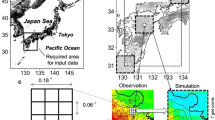Abstract
This study has developed sampling downscaling (SmDS), in which dynamical downscaling (DDS) is executed for a few of period selected from a long-term integration by general circulation model based on an observed statistical relationship between large-scale climate and regional-scale precipitation. SmDS expectedly produces climatology and frequency distribution of precipitation over a nested region with reducing computational cost, if a global-scale climate pattern mostly controls regional-scale weather statistics. Here SmDS was attempted for wintertime precipitation over Hokkaido, Japan, because a linkage between snowfall and sea-level pressure patterns has been known by Japanese synopticians and it can be detected by singular value decomposition (SVD) analysis on wintertime inter-annual variability during the period from 1980/1981 to 2009/2010 for precipitation over Hokkaido and moisture flux convergence around there. DDS for the full period over the same domain was also performed for comparison with SmDS. SmDS selected two winters from the top and two winters from the bottom of the projection onto the first SVD mode. It was found that, comparing with the full DDS, SmDS indeed provided unbiased statistics for average but exaggerated extreme statistics such as heavy rainfall frequency. It was also shown that the sampling in the SmDS method was much more effective than the random sampling.













Similar content being viewed by others
References
Beaulant AL, Joly B, Nuissier O, Somot S, Ducrocq V, Joly A, Sevault F, Deque M, Ricard D (2011) Statistico-dynamical downscaling for Mediterranean heavy precipitation. Q J R Meteorol Soc 137:736–748
Bresson R, Laprise R (2011) Scale-decomposed atmospheric water budget over North America as simulated by the Canadian Regional Climate Model for current and future climates. Clim Dyn 36:365–384
Bretherton CS, Smith C, Wallace JM (1992) An intercomparison of methods for finding coupled patterns in climate data. J Clim 5:541–560
Chu JL, Yu PS (2010) A study of the impact of climate change on local precipitation using statistical downscaling. J Geophys Res 115:D10105
Collins WD et al (2006) The community climate system model version 3 (CCSM3). J Clim 19:2122–2143
Di Luca A, de Elía R, Laprise R (2012) Potential for added value in precipitation simulated by high-resolution nested Regional Climate Models and observations. Clim Dyn 38:1229–1247
Fuentes U, Heimann D (2000) An improved statistical–dynamical downscaling scheme and its application to the Alpine precipitation climatology. Theor Appl Climatol 65:119–135
Giorgi F, Bates GT (1989) The climatological skill of a regional model over complex terrain. Mon Weather Rev 117:2325–2347
Giorgi F, Marinucci MR, Visconti G (1990) Use of a limited-area model nested in a general circulation model for regional climate simulation over Europe. J Geophys Res 95:18413–18431
Giorgi F, Jones C, Asrar GR (2009) Addressing climate information needs at the regional level: the CORDEX framework. WMO Bull 58:175–183
Gong DY, Wang SW, Zhu JH (2001) East Asian winter monsoon and Arctic Oscillation. Geophys Res Lett 28:2073–2076
Hasumi H, Emori S (eds) (2004) K-1 coupled GCM (MIROC) description. K-1 technical report 1, CCSR, Univ of Tokyo, Tokyo
Haylock MR, Goodess CM (2004) Interannual variability of European extreme winter rainfall and links with mean large-scale circulation. Int J Clim 24:759–776
Ishizaki NN et al (2012) Improved performance of simulated Japanese climate with a multi-model ensemble. J Meteorol Soc Jpn 90:235–254
Jhun JG, Lee EJ (2004) A new East Asian winter monsoon index and associated characteristics of the winter monsoon. J Clim 17:711–726
Kain J, Fritsch J (1993) Convective parameterization for mesoscale models: The Kain–Fritsch scheme. The representation of cumulus convection in numerical models. Am Meteorol Soc in Meteorol Monogr 46:165–170
Kamiguchi K, Arakawa O, Kitoh A, Yatagai A, Hamada A, Yasutomi N (2010) Development of APHRO_JP, the first Japanese high-resolution daily precipitation product for more than 100 years. Hydrol Res Lett 4:60–64
Kang IS, Ho CH, Lim YK, Lau KM (1999) Principal modes of climatological seasonal and intraseasonal variations of the Asian Summer Monsoon. Mon Weather Rev 127:322–340
Linden P, Mitchell JFB (eds) (2009) ENSEMBLES: climate change and its impacts: summary of research and results from the ENSEMBLES project. Met Office Hadley Centre, Exeter
Luo D, Diao Y, Feldstein SB (2011) The variability of the Atlantic storm track and the North Atlantic Oscillation: a link between intraseasonal and interannual variability. J Atmos Sci 68:577–601
Olsson J, Uvo CB, Jinno K, Kawamura A, Nishiyama K, Koreeda N, Nakashima T, Morita O (2004) Neural networks for rainfall forecasting by atmospheric downscaling. J Hydrol Eng 91:1–12
Onogi K et al (2007) The JRA-25 reanalysis. J Meteorol Soc Jpn 85:369–432
Rasmusson EM (1968) Atmospheric water vapor transport and the water balance of North America. II: large-scale water balance investigations. Mon Weather Rev 96:720–734
Rife DL, Vanvyve E, Pinto JO, Monaghan AJ, Davis CA, Poulos GS (2013) Selecting representative days for more efficient dynamical climate downscaling: application to wind energy. J Appl Meteorol Climatol 52:47–63
Roeckner E et al (2003) The atmospheric general circulation model ECHAM5. Part I: model description. MPI for Meteorol Rep 349, MPI for Meteorol, Hamburg
Ropelewski CF, Halpert MS (1987) Global and regional scale precipitation patterns associated with the El Niño/Southern Oscillation. Mon Weather Rev 115:1606–1626
Saito K et al (2006) The operational JMA nonhydrostatic mesoscale model. Mon Weather Rev 134:1266–1298
Satoh M, Matsuno T, Tomita H, Miura H, Nasuno T, Iga S (2008) Nonhydrostatic icosahedral atmospheric model (NICAM) for global cloud resolving simulations. J Comp Phys 227:3486–3514
Takano Y, Tachibana Y, Iwamoto K (2008) Influences of large-scale atmospheric circulation and local sea surface temperature on convective activity over the Sea of Japan in December. SOLA 4:113–116
Taylor KE (2001) Summarizing multiple aspects of model performance in a single diagram. J Geophys Res 106:7183–7192
Ummenhofer CC, England MH (2007) Interannual extremes in New Zealand precipitation linked to modes of Southern Hemisphere climate variability. J Clim 20:5418–5440
von Storch H, Zorita E, Cubasch U (1993) Downscaling of global climate change estimates to regional scales: an application to Iberian rainfall in wintertime. J Clim 6:1161–1171
Wallace JM, Gutzler DS (1981) Teleconnections in the geopotential height field during the Northern Hemisphere winter. Mon Weather Rev 109:784–812
Wallace JM, Smith C, Bretherton CS (1992) Singular value decomposition of wintertime sea surface temperature and 500-mb height anomalies. J Clim 5:561–576
Wang B, LinHo (2002) Rainy season of the Asian-Pacific summer monsoon. J Clim 15:386–398
Wang YQ, Leung LR, Mcgregor JL, Lee DK, Wang WC, Ding Y, Kimura F (2004) Regional climate modeling: progress, challenges, and prospects. J Meteorol Soc Jpn 82:1599–1628
Wang SY, Gillies RR, Takle ES, Gutowski WJ (2009) Evaluation of precipitation in the intermountain region as simulated by the NARCCAP regional climate models. Geophys Res Lett 36:L11704
Wettstein JJ, Wallace JM (2010) Observed patterns of month-to-month storm-track variability and their relationship to the background flow. J Atmos Sci 67:1420–1437
Wilby RL, Charles SP, Zorita E, Timbal B, Whetton P, Mearns LO (2004) Guidelines for use of climate scenarios developed from statistical downscaling methods. Supporting material of the IPCC. http://www.ipccdata.org/guidelines/dgm_no2_v1_09_2004.pdf. Accessed 23 Nov 2012
Yasunari T (1991) The monsoon year—a new concept of the climate year in the tropics. Bull Am Meteorol Soc 72:1331–1338
Yatagai A, Kamiguchi K, Arakawa O, Hamada A, Yasutomi N, Kitoh A (2012) APHRODITE: constructing a long-term daily gridded precipitation dataset for Asia based on a dense network of rain gauges. Bull Am Meteorol Soc 93:1401–1415
Acknowledgments
We would like to thank an anonymous reviewer, whose insightful comments helped us improve the manuscript. We also thank Prof. Shoshiro Minobe, Dr. Tomohito J. Yamada, and Dr. Tomonori Sato, Dr. Yoshinori Sasaki, and Prof. Toshiki Iwasaki for giving us insightful comments on our earlier results. Dr. Noriko Ishizaki helped us to run RAM experiments. This work was mainly supported by the Research Program on Climate Change Adaptation, Ministry of Education, Culture, Sports, Science and Technology, and partly supported by Program for Risk Information on Climate Change and the Grant-in-Aid for Scientific Research on Innovative Areas 22106008. The JMA/MRI-NHM and JRA25/JCDAS reanalysis data were used with permission of the JMA. The model simulations were performed using the Hokkaido University High Performance Computing System. Figures were drawn using Grid Analysis and Display System.
Author information
Authors and Affiliations
Corresponding author
Rights and permissions
About this article
Cite this article
Kuno, R., Inatsu, M. Development of sampling downscaling: a case for wintertime precipitation in Hokkaido. Clim Dyn 43, 375–387 (2014). https://doi.org/10.1007/s00382-014-2060-5
Received:
Accepted:
Published:
Issue Date:
DOI: https://doi.org/10.1007/s00382-014-2060-5




